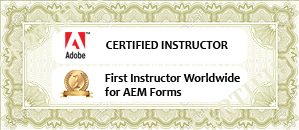Create and Manage Correspondences using AEM 6.x
Duration:2 Days

Overview
Learn how to properly create data dictionaries, layouts, and document fragments and put them together as a correspondence letter. No programming involved.
Course Description
Correspondence Management is an AEM forms and Adobe LiveCycle component that streamlines and simplifies correspondence creation and distribution workflows, within and outside an organization. The Correspondence Management workshop provides a solid foundation for those seeking to understand and implement the core principles of Correspondence Management for managing business critical customer correspondences. It guides you through the recommended workflow and best practices for implementing Correspondence Management.
Objectives
After completing this course, the participant will be able to:
- Deploy and manage templates and content in an intuitive interface designed for business users
- Quickly assemble correspondence from both pre-approved and custom-authored content
Prerequisites
The participant should have basic understanding of LiveCycle server technologies and tools, such as LiveCycle Designer and Workbench.
Audience
This course is designed for those who need to implement correspondence management to their forms using AEM.
Training Methods
- Classroom Training
- On-site at client’s facility anywhere
- Virtual/Online Training
Course Outline
 Download as PDF
Download as PDF
- Introduction
- Benefits
- Introduction
- Create a data dictionary
- Working with test data
- Samples
- Common Attributes associated with a DDE
- Data type mapping between XSD and data dictionary
- Export a sample data file from a data dictionary
- Internationalization of meta data
- Data Dictionary validations
- Mapping Data Dictionary Elements to XML schema
- Mapping Simple (Primitive) Elements
- Text
- List
- Conditions
- Layout Fragments
- Creating tables using layout fragments
- Creating expressions and remote functions with expression builder
- Creating a layout for letters
- Using schema
- Creating relatable fields
- Deciding when to use subforms and text fields
- Setting up repetitive elements
- Specify the server render format
- Create correspondence in the Create Correspondence user interface
- Saving drafts and submitting letter instances
- Rendition modes of letter preview: Mobile forms preview and PDF preview
- Correspondence Management workflow
- Deconstructing a letter
- Analyze a letter before you construct it
- Benefits of performing the analysis
- Correspondence complexity
- Overview of Creating a Letter
- Create a letter template
- Types of linkage available for each of the fields
- Overview
- Adding agent signature image
Hands-on exercises
- Post Processing
- Forms workflow
- AEM workflow
- Letter Instances Retrieval
- Associating a post process with a letter
- Reload a draft letter instance
- Approaches to migration
- Prerequisites
- Installing the Migration utility
- Using the Migration utility
- Changes in Correspondence Management due to migration
- Overview
- Customize fonts by editing the tbxeditor- config.xml file in CRX
- Add custom fonts to the client computer
- Access font customizations
- Overview
- Creating the required folder structure
- Upload the new logo to CRX
- Create the CSS to integrate the logo with the UI
- Refresh the Create Correspondence UI to see the custom logo
- Overview
- Scenario: Create the button in the Create Correspondence User Interface to send a letter for review
- Send letter for review
- Scenario: Adding a common property to all the asset types
- Scenario: Common tab for all asset types
- Scenario: Adding custom properties for specific asset types
- Overview
- Scenario: Add a command to the Letters list user interface to download flat PDF version of a letter
- Download flat PDF of a letter using the custom functionality



 +1(844) 746-6289
+1(844) 746-6289



